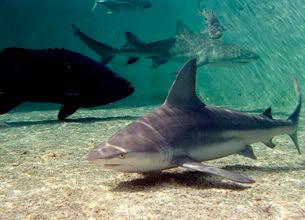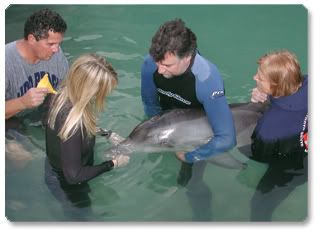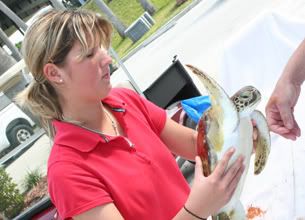Wheelchairs are available on a first-come, first-served basis free of charge. Strollers are not available.
Explore the secrets of the sea with touch pools, shark, dolphin, manatee and sea turtle exhibits and over 100 other species of marine life. Viewable working labs and high-tech interactive exhibits showcase the world-renowned research of Mote Marine Laboratory.
From the Rivers to the Seas: Start your Mote Aquarium tour with a look at freshwater Florida. Most of the state’s 24 major rivers drain into the Gulf of Mexico. Another 7,800 lakes are home to a variety of animals. Among the animals featured in this exhibit: Apple snails, crawfish and – would you believe – stingrays that can live in fresh water.
Florida habitats: 70% of the fish in tropical and subtropical waters – like Southwest F lorida’s – are either born or grow up in estuaries where the rivers meet the sea and salt and fresh water mix. Meet some of the fish that call estuaries home: cowfish, filefish, puffers and striped burr fish, and get to know Florida’s premiere gamefish – the snook.
lorida’s – are either born or grow up in estuaries where the rivers meet the sea and salt and fresh water mix. Meet some of the fish that call estuaries home: cowfish, filefish, puffers and striped burr fish, and get to know Florida’s premiere gamefish – the snook.
A highlight of Mote Aquarium’s indoor exhibits featuring bay inhabitants is the seahorse exhibit. Seahorses – which are typically monogamous – have a unique reproductive story: the males carry the babies. A male seahorse becomes “pregnant” when a female deposits eggs in a male’s pouch. The male seahorse fertilizes the eggs in his pouch and pregnancy usually lasts two to three weeks.
At Mote Aquarium, the lined seahorses (Hippocampus erectus) hitch to each others tails every morning, connecting the belly and pouch together so the female can release eggs to the male’s pouch. On most days there is no exchange, but still the mating dance occurs. The best part? The male and the female form the shape of a heart when they hitch together.
Contact Cove: Think you like Florida’s sea creatures? Get even closer at Contact Cove. Sea stars, horseshoe crabs, sea urchins and other animals are all within reach.
Ray Touch pool: Visit Florida’s Gulf Coast beaches and someone’s probably going to warn you to “do the stingray shuffle” – that is, to shuffle your feet as you walk in the water to avoid stepping on a ray and being stung with its barbed tail. No such worry here. The barbs have been removed so you can feel the ray’s velvety surface as it gracefully glides beneath your hand.
Manatee Habitat: Hugh and Buffett are the only manatees in the world that are trained to participate in research. Through their work with these mammals, scientists have learned much about how well manatees hear, how well they see and how sensitive their vibrasse – the hairs on the end of their snouts – are. Answering these important biological questions can help scientists understand more about Hugh’s and Buffett’s wild counterparts and give that information to the agencies that monitor this endangered population. Hugh and Buffett eat about 72 heads of lettuce a day!
Shark Habitat: Here continues the shark obsession with the – after all, as the nation’s only congressionally designated Center for Shark Research, they have to!
 Florida has nurse sharks, bull sharks, blacktips and sandbar sharks – among others – and you can get closer than you’d like at Mote’s 135,000-gallon shark habitat. This exhibit is also home to the world’s largest grouper species, the goliath grouper (yes, he’s a cousin to Florida ’s favorite seafood dish) and some of the world’s most sporting fish: tarpon, snook and redfish. That’s nearly a grand slam, by local angling lore.
Florida has nurse sharks, bull sharks, blacktips and sandbar sharks – among others – and you can get closer than you’d like at Mote’s 135,000-gallon shark habitat. This exhibit is also home to the world’s largest grouper species, the goliath grouper (yes, he’s a cousin to Florida ’s favorite seafood dish) and some of the world’s most sporting fish: tarpon, snook and redfish. That’s nearly a grand slam, by local angling lore.
Sea Turtles: Hang Tough is a green sea turtle brought to Mote from Bull Bay in Charlotte Harbor in 1992. Hang Tough had a hook in one eye and a puncture wound to the top of the head, along with a skull fracture. The turtle’s other eye was recessed and permanently closed. Because Hang Tough was permanently blind, state officials decided that the turtle could not be released. By caring for him since that time, Mote scientists and animal care experts have learned much about the nutrition habits of green turtles, how to care for a blind turtle and the reasons why some turtles are blind.
Edgar is a juvenile loggerhead sea turtle that came to Mote as a hatchling – baby turtle – in 1992. Edgar was found by members of Mote’s Sea Turtle Conservation Program who monitor more than 30 miles of Southwest Florida beaches for sea turtle activity during the May through October sea turtle nesting season.
The sea turtle volunteers and staff walk the beaches to determine the number of turtle nests and hatchlings each season, and set up devices to make sure that nests are protected from predators and other dangers. Part of that work involves excavating nests where hatchlings have emerged, to make sure there are no turtles left behind.
Edgar was found during one such excavation with unusually light pigmentation and in an extremely lethargic condition. His light color put him at risk for sunburn (that’s right, even turtles can get sunburns).
This turtle was deemed unreleasable by state officials and has been living at Mote ever since. Edgar helped animal care experts learn how to feed baby turtles, which enables staff to take care of other sick hatchlings until they can be released
 Dolphin & Whale Hospital: Mote Marine Laboratory’s Dolphin & Whale Hospital provides state-of-the-art critical care and chronic care for stranded dolphins and whales. The hospital’s mission is to rehabilitate these animals and return them to the wild. Staff seek to learn information that will expand our knowledge of the basic biology, the veterinary care and the disease processes of these mammals.
Dolphin & Whale Hospital: Mote Marine Laboratory’s Dolphin & Whale Hospital provides state-of-the-art critical care and chronic care for stranded dolphins and whales. The hospital’s mission is to rehabilitate these animals and return them to the wild. Staff seek to learn information that will expand our knowledge of the basic biology, the veterinary care and the disease processes of these mammals.
With the animals that are released back into the wild, they make every effort to do follow-up monitoring, which tells them how successful the rehabilitation was and adds to the basic understanding of the short- and long-term movements of these animals.
Sea Turtle Rehabilitation Hospital:  Mote’s Sea Turtle Rehabilitation Hospital provides state-of-the-art critical care and chronic care for stranded sea turtles. The hospital’s mission is to rehabilitate these animals and return them to the wild. Staff seek to learn information that will expand our knowledge of the basic biology, the veterinary care and the disease processes of sea turtles. With the animals that are released back into the wild, they make every effort to do follow-up monitoring, which tells us how successful the rehabilitation was and adds to the basic understanding of the short- and long-term movements of these animals.
Mote’s Sea Turtle Rehabilitation Hospital provides state-of-the-art critical care and chronic care for stranded sea turtles. The hospital’s mission is to rehabilitate these animals and return them to the wild. Staff seek to learn information that will expand our knowledge of the basic biology, the veterinary care and the disease processes of sea turtles. With the animals that are released back into the wild, they make every effort to do follow-up monitoring, which tells us how successful the rehabilitation was and adds to the basic understanding of the short- and long-term movements of these animals.

No comments yet.